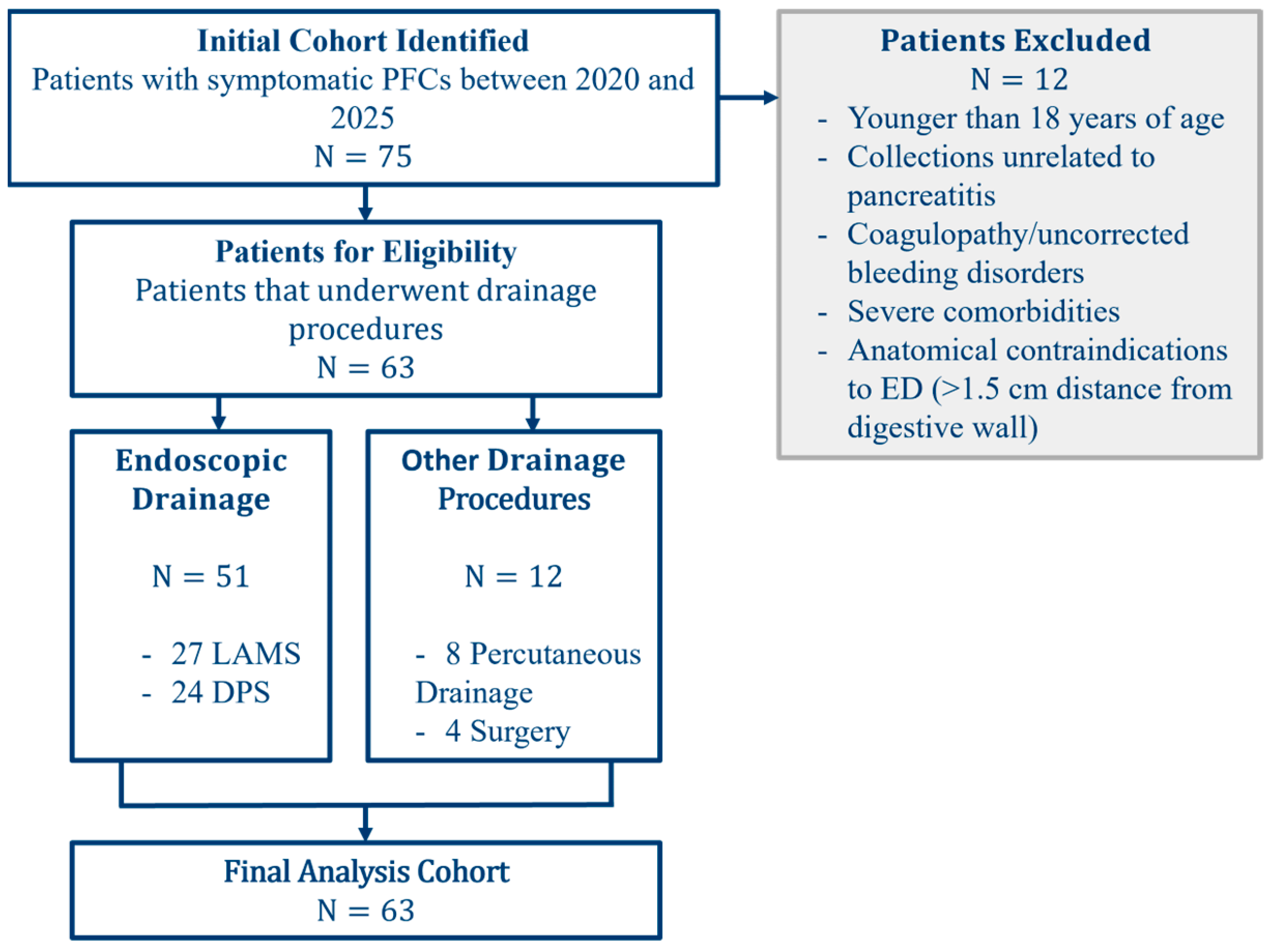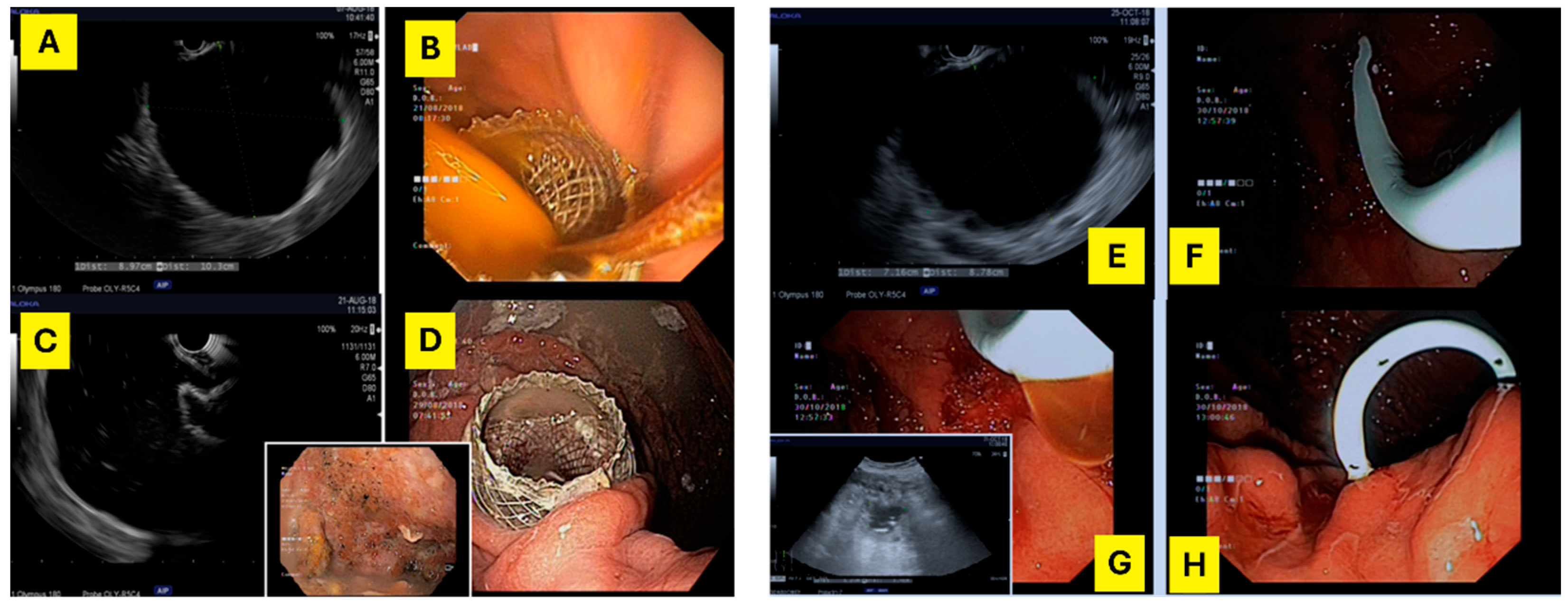Choosing Wisely: Tailored Drainage Strategies for Peripancreatic Fluid Collections—A Tertiary Center’s Experience
Abstract
1. Introduction
2. Materials and Methods
3. Results
4. Discussion
5. Conclusions
Author Contributions
Funding
Institutional Review Board Statement
Informed Consent Statement
Data Availability Statement
Conflicts of Interest
Abbreviations
| Abbreviation | Full Form |
| AGA | American Gastroenterological Association |
| ANOVA | Analysis of Variance |
| CI | Confidence Interval |
| DDS | Disconnected Pancreatic Duct Syndrome |
| DEN | Direct Endoscopic Necrosectomy |
| DPS | Double Pigtail (Plastic) Stent |
| ED | Endoscopic Drainage |
| EUS | Endoscopic Ultrasound |
| ESGE | European Society of Gastrointestinal Endoscopy |
| Fr | French (catheter/stent size unit) |
| LAMS | Lumen-Apposing Metal Stent |
| LOS | Length of Hospital Stay |
| MRCP | Magnetic Resonance Cholangiopancreatography |
| PD | Percutaneous Drainage |
| PFC(s) | Peripancreatic Fluid Collection(s) |
| PP(s) | Pancreatic Pseudocyst(s) |
| RR | Relative Risk |
| SD | Standard Deviation |
| SPSS | Statistical Package for the Social Sciences |
| WON | Walled-Off Necrosis |
References
- Banks, P.A.; Bollen, T.L.; Dervenis, C.; Gooszen, H.G.; Johnson, C.D.; Sarr, M.G.; Tsiotos, G.G.; Vege, S.S.; Acute Pancreatitis Classification Working Group. Classification of acute pancreatitis—2012: Revision of the Atlanta classification and definitions by International Consensus. Gut 2013, 62, 102–111. [Google Scholar] [CrossRef] [PubMed]
- Capurso, G.; Rizzo, G.E.M.; Coluccio, C.; Crinò, S.F.; Cucchetti, A.; Facciorusso, A.; Hassan, C.; Amato, A.; Auriemma, F.; Bertani, H.; et al. i-EUS working group. The i-EUS consensus on the management of pancreatic fluid collections—Part 1. Dig. Liver Dis. Off. J. Ital. Soc. Gastroenterol. Ital. Assoc. Study Liver 2024, 56, 1663–1674. [Google Scholar]
- Capurso, G.; Rizzo, G.E.M.; Coluccio, C.; Crinò, S.F.; Cucchetti, A.; Facciorusso, A.; Hassan, C.; Amato, A.; Auriemma, F.; Bertani, H.; et al. Contributors as part of the i-EUS Working Group. The 1st i-EUS consensus on the management of pancreatic fluid collections—Part 2. Dig. Liver Dis. Off. J. Ital. Soc. Gastroenterol. Ital. Assoc. Study Liver 2024, 56, 1819–1827. [Google Scholar]
- Ramai, D.; Enofe, I.; Deliwala, S.S.; Mozell, D.; Facciorusso, A.; Gkolfakis, P.; Mohan, B.P.; Chandan, S.; Previtera, M.; Maida, M.; et al. Early (<4 weeks) versus standard (≥4 weeks) endoscopic drainage of pancreatic walled-off fluid collections: A systematic review and meta-analysis. Gastrointest. Endosc. 2023, 97, 415–421.e5. [Google Scholar]
- Baron, T.H.; DiMaio, C.J.; Wang, A.Y.; Morgan, K.A. American Gastroenterological Association Clinical Practice Update: Management of Pancreatic Necrosis. Gastroenterology 2020, 158, 67–75.e1. [Google Scholar] [CrossRef]
- Khan, M.A.; Hammad, T.; Khan, Z.; Lee, W.; Gaidhane, M.; Tyberg, A.; Kahaleh, M. Endoscopic versus percutaneous management for symptomatic pancreatic fluid collections: A systematic review and meta-analysis. Endosc. Int. Open 2018, 6, E474–E483. [Google Scholar] [CrossRef]
- Tan, S.; Zhong, C.; Ren, Y.; Luo, X.; Xu, J.; Peng, Y.; Fu, X.; Tang, X. Are Lumen-Apposing Metal Stents More Effective Than Plastic Stents for the Management of Pancreatic Fluid Collections: An Updated Systematic Review and Meta-analysis. Gastroenterol. Res. Pract. 2020, 2020, 4952721. [Google Scholar] [CrossRef]
- Mangiavillano, B.; Lakhtakia, S.; Samanta, J.; Auriemma, F.; Vargas-Madrigal, J.; Arcidiacono, P.G.; Barbera, C.; Ashhab, H.; Song, T.J.; Pham, K.D.; et al. PFC LAMS study group. Lumen-apposing metal stents for the treatment of pancreatic and peripancreatic fluid collections and bleeding risk: A propensity matched study. Endoscopy 2024, 56, 249–257. [Google Scholar]
- Boxhoorn, L.; Verdonk, R.C.; Besselink, M.G.; Boermeester, M.; Bollen, T.L.; Bouwense, S.A.; Cappendijk, V.C.; Curvers, W.L.; Dejong, C.H.; van Dijk, S.M.; et al. Dutch Pancreatitis Study Group. Comparison of lumen-apposing metal stents versus double-pigtail plastic stents for infected necrotising pancreatitis. Gut 2023, 72, 66–72. [Google Scholar] [CrossRef]
- Das, K.; Kochhar, R.; Kaushik, S.P.; Gupta, N.M.; Mehta, S.K.; Suri, S.; Wig, J.D. Double pigtail cystogastric stent in the management of pancreatic pseudocyst. J. Clin. Ultrasound JCU 1992, 20, 11–17. [Google Scholar] [CrossRef]
- Gornals, J.B.; Velasquez-Rodriguez, J.G.; Bas-Cutrina, F.; Garcia, G.D.P.A.; Esteban, J.M.; Teran, A.; Gonzalez-Huix, F.; Perez-Miranda, M.; Guarner-Argente, C.; Vila, J.J.; et al. Spanish Working Group on Pancreatic Collection Therapy. Plastic pigtail vs lumen-apposing metal stents for drainage of walled-off necrosis (PROMETHEUS study): An open-label, multicenter randomized trial. Surg. Endosc. 2024, 38, 2148–2159. [Google Scholar] [CrossRef]
- Abusuliman, M.; Jamali, T.; Nimri, F.; Chaudhary, A.J.; Elfert, K.; Saleem, A.; Alomari, A.; Faisal, M.S.; Shamaa, O.; Obri, M.; et al. Analysis of Adverse Events of Endoscopic Ultrasound-Guided Lumen-Apposing Metal Stent Placement: Insights Across Various Indications and Techniques. Gastroenterol. Res. 2025, 18, 1–11. [Google Scholar]
- Bang, J.Y.; Hawes, R.H.; Varadarajulu, S. Lumen-apposing metal stent placement for drainage of pancreatic fluid collections: Predictors of adverse events. Gut 2020, 69, 1379–1381. [Google Scholar] [CrossRef]
- Chen, Y.I.; Khashab, M.A.; Adam, V.; Bai, G.; Singh, V.K.; Bukhari, M.; Brewer Gutierrez, O.; Elmunzer, B.J.; Moran, R.A.; Fayad, L.; et al. Plastic stents are more cost-effective than lumen-apposing metal stents in management of pancreatic pseudocysts. Endosc. Int. Open 2018, 6, E780–E788. [Google Scholar] [CrossRef]
- Khizar, H.; Zhicheng, H.; Chenyu, L.; Yanhua, W.; Jianfeng, Y. Efficacy and safety of endoscopic drainage versus percutaneous drainage for pancreatic fluid collection; a systematic review and meta-analysis. Ann. Med. 2023, 55, 2213898. [Google Scholar] [CrossRef]
- Arvanitakis, M.; Dumonceau, J.M.; Albert, J.; Badaoui, A.; Bali, M.A.; Barthet, M.; Besselink, M.; Deviere, J.; Oliveira, F.A.; Gyökeres, T.; et al. Endoscopic management of acute necrotizing pancreatitis: European Society of Gastrointestinal Endoscopy (ESGE) evidence-based multidisciplinary guidelines. Endoscopy 2018, 50, 524–546. [Google Scholar] [CrossRef]
- Vanella, G.; Leone, R.; Frigo, F.; Rossi, G.; Zaccari, P.; Palumbo, D.; Guazzarotti, G.; Aleotti, F.; Pecorelli, N.; Preatoni, P.; et al. Predicting the need for step-up after EUS-guided drainage of peripancreatic fluid collections, including Quadrant-Necrosis-Infection score validation: A prospective cohort study. Gastrointest. Endosc. 2025, 102, 362–372.e8. [Google Scholar] [CrossRef]
- Yuen, R.; Lam, B.; Chan, S.M.; Yip, H.C.; Teoh, A.Y.B. Comparison of Direct Endoscopic Necrosectomy With Endoscopic Step-Up Approach After Endoscopic Drainage of Pancreatic Walled-Off Necrosis: Systematic Review and Meta-Analysis. Dig. Endosc. Off. J. Jpn. Gastroenterol. Endosc. Soc. 2025. Advance online publication. [Google Scholar] [CrossRef] [PubMed]
- Verma, S.; Rana, S.S. Disconnected pancreatic duct syndrome: Updated review on clinical implications and management. Pancreatol. Off. J. Int. Assoc. Pancreatol. (IAP) 2020, 20, 1035–1044. [Google Scholar] [CrossRef] [PubMed]
- Satyam, S.; Singh, S.; Sah, P.K. Disconnected Pancreatic Duct Syndrome: A Case Series. Euroasian J. Hepato-Gastroenterol. 2022, 12, 60–63. [Google Scholar]
- Vanek, P.; Urban, O.; Trikudanathan, G.; Freeman, M.L. Disconnected pancreatic duct syndrome in patients with necrotizing pancreatitis. Surg. Open Sci. 2022, 11, 19–25. [Google Scholar] [CrossRef] [PubMed]
- Takenaka, M.; Saito, T.; Hamada, T.; Omoto, S.; Shiomi, H.; Iwashita, T.; Masuda, A.; Matsubara, S.; Maruta, A.; Iwata, K.; et al. Disconnected pancreatic duct syndrome: Diagnostic and therapeutic challenges and future directions. Expert Rev. Gastroenterol. Hepatol. 2024, 18, 631–645. [Google Scholar] [CrossRef] [PubMed]
- Bhatia, H.; Yadav, N.; Gupta, P. Radiological criteria for disconnected pancreatic duct syndrome: A targeted literature review. Expert Rev. Gastroenterol. Hepatol. 2022, 16, 121–127. [Google Scholar] [CrossRef]
- Jearth, V.; Rana, S.S. Endoscopic step up: When and how. Surg. Open Sci. 2022, 10, 135–144. [Google Scholar] [CrossRef] [PubMed]



| Variable | Total (N = 63) | LAMS (N = 27) | DPS (N = 24) | Other (N = 12) |
|---|---|---|---|---|
| Age, years (mean ± sd) | 54.8 ± 14.3 | 53 ± 14.3 | 59 ± 13.9 | 50.4 ± 14 |
| Gender, male (%) | 44 (69.8%) | 17 (62.3%) | 17 (70.8%) | 9 (75.0%) |
| Type of collection, n (%) | ||||
| Pc | 37 (58.7%) | 8 (29.6%) | 22 (91.7%) | 7 (58.3%) |
| Won | 26 (41.3%) | 19 (70.4%) | 3 (12.5%) | 5 (41.7%) |
| Size of collection, cm (mean ± sd) | 11.5 ± 7.2 | 11.74 ± 3.41 | 12.29 ± 10.8 | 9.6 ± 4 |
| Location, n (%) | ||||
| Head | 6 (9.5%) | 3 (11.1%) | 3 (12.5%) | 0 (0.0%) |
| Head-body | 6 (9.5%) | 1 (3.7%) | 4 (16.7%) | 1 (8.3%) |
| Body | 29 (46.0%) | 12 (44.4%) | 11 (45.8%) | 6 (50.0%) |
| Body-tail | 19 (30.2%) | 9 (33.3%) | 4 (16.7%) | 5 (41.7%) |
| Tail | 3 (4.8%) | 1 (3.7%) | 2 (8.3%) | 0 (0.0%) |
| Extent of pancreatic necrosis, n (%) | ||||
| No necrosis | 14 (22.2%) | 1 (3.7%) | 11 (45.8%) | 2 (16.7%) |
| <30% | 14 (22.2%) | 9 (33.3%) | 3 (12.5%) | 2 (16.7%) |
| 30–50% | 18 (28.6%) | 12 (44.4%) | 4 (16.7%) | 2 (16.7%) |
| >50% | 9 (14.3%) | 4 (14.8%) | 0 (0.0%) | 5 (41.7%) |
| Variable | Endoscopic Drainage | Other (N = 12) | p Value | Relative Risk/Mean Difference (95% CI) | |
|---|---|---|---|---|---|
| LAMS (N = 27) | DPS (N = 24) | ||||
| Reduction of the collection (≥50%) | 20 (74.1%) | 18 (75.0%) | 3 (25.0%) | 0.0022 | 2.98 (95% CI 1.10 to 8.05) |
| Need for den (no, %) | 14 (51.9%) | 0 (0.0%) | 2 (16.7%) | 0.7140 | 1.65 (95% CI 0.43 to 6.30) |
| Complications (no, %) | 5 (18.5%) | 6 (25.0%) | 7 (58.3%) | 0.0281 | 0.37 (95% CI 0.18 to 0.75) |
| Death (no, %) | 0 (0.0%) | 2 (8.3%) | 1 (8.3%) | 0.9999 | 0.47 (95% CI 0.08 to 27.52) |
| Recurrence (NO, %) | 1 (3.7%) | 2 (8.3%) | 0 (0.0%) | 0.9999 | 1.47 (95% CI 0.08 to 27.52) |
| Costs (Euro, mean ± SD) | 4545.9 ± 3494.2 | 3363.3 ± 2196.7 | 8732 ± 10,503.1 | 0.1485 | −€4742.6 (95% CI −11.448.91 to +1.963.75) |
| Hospital stay (days, mean ± SD) | 8.4 ± 7.2 | 7.3 ± 5.6 | 17.1 ± 9.0 | 0.0048 | −9.2 days (95% CI −15.13 to −3.31) |
Disclaimer/Publisher’s Note: The statements, opinions and data contained in all publications are solely those of the individual author(s) and contributor(s) and not of MDPI and/or the editor(s). MDPI and/or the editor(s) disclaim responsibility for any injury to people or property resulting from any ideas, methods, instructions or products referred to in the content. |
© 2025 by the authors. Licensee MDPI, Basel, Switzerland. This article is an open access article distributed under the terms and conditions of the Creative Commons Attribution (CC BY) license (https://creativecommons.org/licenses/by/4.0/).
Share and Cite
Dascalu, R.-I.; Ilie, M.; Turculet, C.S.; Popa, B.V.; Constantinescu, G.; Pavel, C.; Rizescu, V.; Bogu, C.-V.; Cabel, T.; Plotogea, O.-M. Choosing Wisely: Tailored Drainage Strategies for Peripancreatic Fluid Collections—A Tertiary Center’s Experience. J. Clin. Med. 2025, 14, 8018. https://doi.org/10.3390/jcm14228018
Dascalu R-I, Ilie M, Turculet CS, Popa BV, Constantinescu G, Pavel C, Rizescu V, Bogu C-V, Cabel T, Plotogea O-M. Choosing Wisely: Tailored Drainage Strategies for Peripancreatic Fluid Collections—A Tertiary Center’s Experience. Journal of Clinical Medicine. 2025; 14(22):8018. https://doi.org/10.3390/jcm14228018
Chicago/Turabian StyleDascalu, Raluca-Ioana, Madalina Ilie, Claudiu Stefan Turculet, Bogdan Valeriu Popa, Gabriel Constantinescu, Christopher Pavel, Vlad Rizescu, Cosmin-Viorel Bogu, Teodor Cabel, and Oana-Mihaela Plotogea. 2025. "Choosing Wisely: Tailored Drainage Strategies for Peripancreatic Fluid Collections—A Tertiary Center’s Experience" Journal of Clinical Medicine 14, no. 22: 8018. https://doi.org/10.3390/jcm14228018
APA StyleDascalu, R.-I., Ilie, M., Turculet, C. S., Popa, B. V., Constantinescu, G., Pavel, C., Rizescu, V., Bogu, C.-V., Cabel, T., & Plotogea, O.-M. (2025). Choosing Wisely: Tailored Drainage Strategies for Peripancreatic Fluid Collections—A Tertiary Center’s Experience. Journal of Clinical Medicine, 14(22), 8018. https://doi.org/10.3390/jcm14228018






